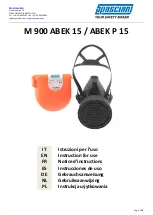
- 53 -
HELIOT
CHAMBER
(1)
When HELIOT is installed to the chamber
In this case, helium that has flown into the chamber through the
leak is pumped by the turbomolecular pump and HELIOT via two
routes.
Since the pumping speed of the fore pumping system is higher
than that of HELIOT in most cases, most of helium flows to the
fore pumping system, with the result that helium flowing to
HELIOT is very little. In this condition, response may be high,
but detecting efficiency is low.
HELIOT
CHAMBER
(2)
When HELIOT is installed to the fore pumping system --- A
In this case, HELIOT is installed between the turbomolecular
pump and the rotary pump. Helium in the chamber is pumped
by the turbomolecular pump only and its exhaust can be taken
into HELIOT. Here, helium is pumped by the rotary pump and
HELIOT independently, but helium detecting efficiency and
response are higher because the difference in pumping speed is
smaller than in case (1).
However, care must be taken in connection, that is, there should
be no pressure difference between the rotary pump and HELIOT.
If the pressure is higher on the rotary pump side than that on the
HELIOT side, oil mist will flow back through the intake port of
the rotary pump to contaminate HELIOT interior and
turbomolecular pump. Problem due to this pressure difference
can be resolved by using gross leak flow and pumping the test
port by the built-in rotary pump.
Summary of Contents for HELIOT 301
Page 88: ......
















































